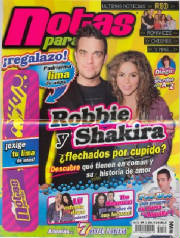 |
 |
 |
 |
 |
 |
 |
|

The younger you are, the more impulsive you tend to be." Shakira says, "I've learned to say those magic
words: "Let me think about it" That gives you time to digest information and make smart decisions

|
|
 |
|

"Artists sometimes get convinced that we always have to be protected and put in a human shell by [bodyguards].
It's not necessary! It's not important! I'm trying to simplify my life."

|
|
 |
 |
 |
 |
 |
 |
 |
|
Shakira is a woman in control of her image and just about everything else. Over the course of the six-hour
shoot, the native of Barranquilla, Colombia, born Shakira Mebarak Ripoll, will be photographed in five outfits - doing her
own makeup for each shot. In between, she'll make and take several business calls, all conducted in her native Spanish (this
reporter, who made the mistake of taking French in high school, picked up only the words for "shoes" and "cold" during the
rapid-fire discussions), as well as edit the video (which she codirected, natch) for her demure Spanish-language track "Dia
de Enero". "If I ever want to quit music," says Shakira, who writes and produces all of her songs, "I could have three alternate
careers."



|
|
 |
|
Shakira may be comfortable gyrating in various stages of undress onstage and in her videos, but she suddenly
becomes modest when shooting her TEEN PEOPLE cover. On a gorgeous California day, it's time to do her first bikini shoot,
and she's rifling through racks of cover-ups, trying to find one that won't leave her infamous belly - arguably the most talked-about
tummy since Britney Spears's - totally exposed


The trek is bound to be a hot ticket: Although practically every Shakira article you read in American magazines
mentions that she's an A-list goddess all over the Latin world, she's such a big star here that even her Spanish-language
releases enjoy enviable sales. Fueling the Fixation fire: Shaki, as friends call her, is climbing the charts with the single
"Hips Don't Lie," her world-music-tinged collaboration with Wyclef Jean. As you might expect, the video prominently features
her midsection as she does her signature belly dances.
|
|
 |
 |
 |
 |
 |
 |
|
After achieving superstardom throughout Latin America, Colombian-born Shakira
became Latin pop's biggest female crossover artist since Jennifer Lopez broke down the doors to English-language success.
Noted for her aggressive, rock-influenced approach, Shakira maintained an extraordinary degree of creative control over her
music, especially for a female artist; she wrote or co-wrote nearly all of her own material, and in the process gained a reputation
as one of Latin music's most ambitiously poetic lyricists. When she released her first English material in late 2001, she
became an instant pop sensation, thanks to her quirky poetic sense and a sexy video image built on her hip-shaking belly-dance
moves. Shakira Mebarak (full name: Shakira Isabel Mebarak Ripoll) was
born February 2, 1977, in Barranquilla, Colombia, into a poor family. Her mother was a native Colombian and her father was
of Lebanese descent, and so as a child Shakira soaked up music from both cultures; she also listened heavily to English-language
rock & roll, listing her favorite bands in later interviews as Led Zeppelin, the Beatles, the Police, the Cure, and Nirvana.
Shakira wrote her first song at age eight, began entering (and winning) talent competitions at age ten, and started learning
the guitar at age 11; one story runs that around this age, she was kicked out of her school choir for singing too forcefully.
In 1990, at age 13, Shakira moved to Bogota in hopes of pursuing a modeling career, but wound up signing a record deal with
Sony's Colombian division instead. Her 1991 debut album, Magia (Magic), was comprised of songs she'd written over the past
five or six years, including some of her earliest efforts. Although it didn't break internationally, the record started to
make a name for her in her home country. Dissatisfied with the pop inclinations of the follow-up, 1993's Peligro (Danger),
Shakira changed direction for a time, joining the cast of the Colombian soap opera El Oasis in 1994. When Shakira returned to recording in 1995, she asserted more control over the direction of her music, and worked more
rock & roll rhythms -- as well as occasional Arabic tinges -- into her Latin pop material. The first results were Pies
Descalzos (Bare Feet), which was initially released in 1995; a slow seller at first, the album gradually caught on thanks
to the rock-tinged single "Estoy Aqui," which became a hit all over Latin America, as well as Spain. After that breakthrough,
Pies Descalzos just kept spinning off singles: "Donde Estas Corazona," "Antologia," "Pienso en Ti," "Un Poco de Amor," "Se
Quiere, Se Mata." The album hit number one in eight different countries and eventually went platinum in the U.S. as well;
Shakira toured for nearly two years promoting it (she finally left El Oasis in 1997). Seeking to build on her success, Shakira signed Emilio Estefan -- Gloria's husband and a highly successful music-biz
insider -- as her manager and producer. The move paid off when her follow-up album, 1998's Donde Estan los Ladronesa (Where
Are the Thieves?), became an even bigger worldwide hit than its predecessor. What was more, it cracked the lucrative U.S.
market wide open, spending 11 weeks at number one on Billboard's Latin album chart and producing two U.S. number ones (on
the Latin chart) with "Ciega, Sordomuda" and "Tu." The album's signature track, however, was the worldwide hit "Ojos Asi,"
her most explicit nod yet to the Arabic music she'd picked up from her father (not to mention its latent belly-dancing connotations).
D?nde Est?n los Ladrones? was also the most effective presentation yet of Shakira's strong-willed persona; her self-analysis
made her even more popular among female fans, while her anger over love gone wrong drew comparisons to Alanis Morissette.
When Gloria Estefan offered to translate "Ojos Asi" into English, the
prospect of a crossover suddenly seemed tangible, and Shakira decided that the most effective way to maintain control over
her material was to learn English well enough to write in it herself. In the meantime, she set the stage for her crossover
bid with a performance on MTV Unplugged; the channel's first Spanish-language broadcast. MTV Unplugged was released as an
album in early 2000, and topped the Latin charts for two weeks on its way to becoming her third straight platinum album; it
also won a Grammy for Best Latin Pop Album. At the inaugural Latin Grammy Awards ceremony in 2000, Shakira delivered a much-discussed,
show-stopping performance of "Ojos As?," and took home Unplugged-related trophies for Best Female Pop Vocal ("Ojos As?") and
Best Female Rock Vocal ("Octavo Dia"). Mainstream
pop stardom beckoned. Shakira dyed her long brown hair blonde, romanced Antonio de la Rua (son of the former president of
Argentina), and went to work on her first (mostly) English-language album, Laundry Service. The single/video "Whenever, Wherever"
was released in advance of the album in late 2001, and made her a star in the English-speaking world almost overnight. Laundry
Service entered the American pop charts at number three, and "Whenever, Wherever" climbed into the Top Ten of the singles
chart, peaking at number six. The follow-up "Underneath Your Clothes" also hit the Top Ten, halting at number nine; less than
a year after its release, Laundry Service had gone triple platinum. Reviews of Laundry Service were divided as to the effectiveness
of Shakira's English lyrics, but nearly all agreed on her unique poetic imagery.
Rock City International. Nicholas Towers. POS.
 |